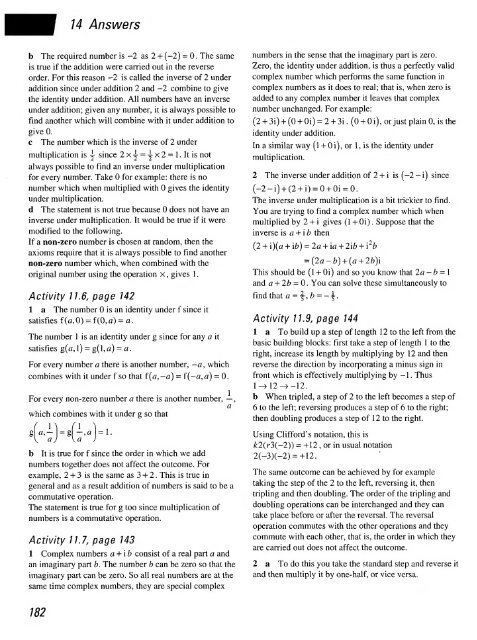history of mathematics - National STEM Centre
history of mathematics - National STEM Centre
history of mathematics - National STEM Centre
You also want an ePaper? Increase the reach of your titles
YUMPU automatically turns print PDFs into web optimized ePapers that Google loves.
14 Answers<br />
b The required number is -2 as 2 + (-2) = 0 . The same<br />
is true if the addition were carried out in the reverse<br />
order. For this reason -2 is called the inverse <strong>of</strong> 2 under<br />
addition since under addition 2 and -2 combine to give<br />
the identity under addition. All numbers have an inverse<br />
under addition; given any number, it is always possible to<br />
find another which will combine with it under addition to<br />
give 0.<br />
c The number which is the inverse <strong>of</strong> 2 under<br />
multiplication is j since 2x^ = ^x2 = 1. It is not<br />
always possible to find an inverse under multiplication<br />
for every number. Take 0 for example: there is no<br />
number which when multiplied with 0 gives the identity<br />
under multiplication.<br />
d The statement is not true because 0 does not have an<br />
inverse under multiplication. It would be true if it were<br />
modified to the following.<br />
If a non-zero number is chosen at random, then the<br />
axioms require that it is always possible to find another<br />
non-zero number which, when combined with the<br />
original number using the operation x , gives 1 .<br />
Activity 11.6, page 142<br />
1 a The number 0 is an identity under f since it<br />
satisfies f(a,0) = f(0,fl) = a.<br />
The number 1 is an identity under g since for any a it<br />
satisfies g(a,l) = g(l,a) = «•<br />
For every number a there is another number, —a, which<br />
combines with it under f so that f(a,—a) = f(-a,a) = 0.<br />
For every non-zero number a there is another number, — ,<br />
a<br />
which combines with it under g so that<br />
b It is true for f since the order in which we add<br />
numbers together does not affect the outcome. For<br />
example, 2 + 3 is the same as 3 + 2 . This is true in<br />
general and as a result addition <strong>of</strong> numbers is said to be a<br />
commutative operation.<br />
The statement is true for g too since multiplication <strong>of</strong><br />
numbers is a commutative operation.<br />
Activity 11.7, page 143<br />
1 Complex numbers a + i b consist <strong>of</strong> a real part a and<br />
an imaginary part b. The number b can be zero so that the<br />
imaginary part can be zero. So all real numbers are at the<br />
same time complex numbers, they are special complex<br />
182<br />
numbers in the sense that the imaginary part is zero.<br />
Zero, the identity under addition, is thus a perfectly valid<br />
complex number which performs the same function in<br />
complex numbers as it does to real; that is, when zero is<br />
added to any complex number it leaves that complex<br />
number unchanged. For example:<br />
(2 + 3i) + (0 + Oi) = 2 + 3i . (0 + 0 i), or just plain 0, is the<br />
identity under addition.<br />
In a similar way (l + Oi), or 1, is the identity under<br />
multiplication.<br />
2 The inverse under addition <strong>of</strong> 2 + i is (-2 -i) since<br />
The inverse under multiplication is a bit trickier to find.<br />
You are trying to find a complex number which when<br />
multiplied by 2 + i gives (1 + Oi) . Suppose that the<br />
inverse is a + ib then<br />
(2 + i)(a + ib) = 2a + ia + 2ib + i 2 b<br />
= (2a-b) + (a + 2b)i<br />
This should be (1 + Oi) and so you know that 2a-b = \<br />
and a + 2b = 0 . You can solve these simultaneously to<br />
find that a = ^,b = -\.<br />
Activity 11.9, page 144<br />
1 a To build up a step <strong>of</strong> length 1 2 to the left from the<br />
basic building blocks: first take a step <strong>of</strong> length 1 to the<br />
right, increase its length by multiplying by 1 2 and then<br />
reverse the direction by incorporating a minus sign in<br />
front which is effectively multiplying by - 1 . Thus<br />
l-> 12-^-12.<br />
b When tripled, a step <strong>of</strong> 2 to the left becomes a step <strong>of</strong><br />
6 to the left; reversing produces a step <strong>of</strong> 6 to the right;<br />
then doubling produces a step <strong>of</strong> 1 2 to the right.<br />
Using Clifford's notation, this is<br />
&2(r3(-2)) = +12 , or in usual notation<br />
The same outcome can be achieved by for example<br />
taking the step <strong>of</strong> the 2 to the left, reversing it, then<br />
tripling and then doubling. The order <strong>of</strong> the tripling and<br />
doubling operations can be interchanged and they can<br />
take place before or after the reversal. The reversal<br />
operation commutes with the other operations and they<br />
commute with each other, that is, the order in which they<br />
are carried out does not affect the outcome.<br />
2 a To do this you take the standard step and reverse it<br />
and then multiply it by one-half, or vice versa.
















